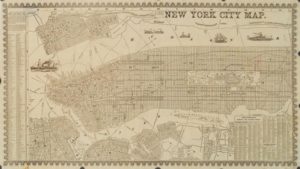New York

Title: New York city map. Date issued: 1860 (questionable) Cartographer: Miller, James (d. 1883) Source: New York Public Library Digital Collections
The city of New York plays a vital role in the story. New York is not only where the protagonist Sara Smolinsky lives with her family but it is also the place that makes Sara grow into the successful woman. Sara’s life in New York, is filled with countless number of obstacles. Whether it be working odd jobs selling herring with a push cart, working in a laundromat, to get mistreated in a soup kitchen/cafeteria, or even getting a small apartment Sara has been through a wringer obstacle. However, these obstacles only make her ambition for her education to be a school teacher even greater. The same New York that gave her those obstacles also gave her the opportunities to be somebody. Sara was able to pursue an education, making her own money, find her own romance, and make her dreams come true. More importantly, New York is directly connected to the idea of the public sphere. According to the article The Image of The City in Yezierska’s Bread Givers by Edith Weinthal, she states “The portrayal of the city in Anzia Yezierska Break Givers demonstrates her response to the culture as perceived by a female Jewish immigrant at the beginning of the century. The city as a literary image in this novel becomes the arena of confrontation of culturally held biases between domestic and public labor and between natural “female” and cultural “male” goals. Yezierska connects the image of the city with the view that domestic life has been devalued while public life has attained an elite position in society” (Weinthal 10). Based off this, we can see how this is related to trials and tribulations that Sara faces in her life. Being from an immigrant family, who focuses on the traditional way of life she is forced to either adhere to it or carve out her destiny. Additionally, the culture in New York is connected to concept of cultural diversity. Sara encounters a wide array of people from all walks of life. It inevitably puts her at a crossroads because she can take one road which is traditional and culturally accepted or take another road where she can experience new endeavors that can help her flourish.
Bibliographic Information
Lionel Pincus and Princess Firyal Map Division, The New York Public Library. “New York city map.” The New York Public Library Digital Collections. 1860. http://digitalcollections.nypl.org/items/9ea0c39c-cad4-4cd3-e040-e00a18066f50
Onetenth110, director. YouTube. YouTube, YouTube, 9 May 2011, www.youtube.com/watch?v=kOrgslc1-Ek&t=60s.
Weinthal, Edith C. “The Image of The City In Yezierska “Bread Givers.” Studies in American Jewish Literature (1981-), vol. 13, 1994, pp. 10–13. JSTOR, JSTOR, www.jstor.org/stable/41205837.


